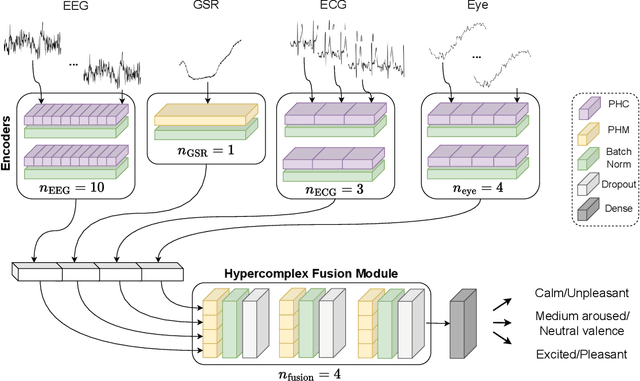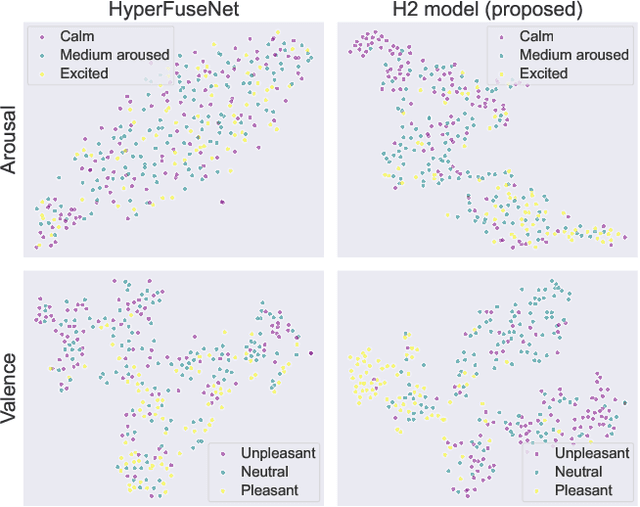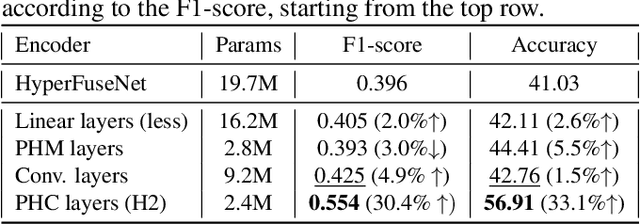Eleonora Lopez
Hierarchical Hypercomplex Network for Multimodal Emotion Recognition
Sep 13, 2024



Abstract:Emotion recognition is relevant in various domains, ranging from healthcare to human-computer interaction. Physiological signals, being beyond voluntary control, offer reliable information for this purpose, unlike speech and facial expressions which can be controlled at will. They reflect genuine emotional responses, devoid of conscious manipulation, thereby enhancing the credibility of emotion recognition systems. Nonetheless, multimodal emotion recognition with deep learning models remains a relatively unexplored field. In this paper, we introduce a fully hypercomplex network with a hierarchical learning structure to fully capture correlations. Specifically, at the encoder level, the model learns intra-modal relations among the different channels of each input signal. Then, a hypercomplex fusion module learns inter-modal relations among the embeddings of the different modalities. The main novelty is in exploiting intra-modal relations by endowing the encoders with parameterized hypercomplex convolutions (PHCs) that thanks to hypercomplex algebra can capture inter-channel interactions within single modalities. Instead, the fusion module comprises parameterized hypercomplex multiplications (PHMs) that can model inter-modal correlations. The proposed architecture surpasses state-of-the-art models on the MAHNOB-HCI dataset for emotion recognition, specifically in classifying valence and arousal from electroencephalograms (EEGs) and peripheral physiological signals. The code of this study is available at https://github.com/ispamm/MHyEEG.
Towards Explaining Hypercomplex Neural Networks
Mar 26, 2024Abstract:Hypercomplex neural networks are gaining increasing interest in the deep learning community. The attention directed towards hypercomplex models originates from several aspects, spanning from purely theoretical and mathematical characteristics to the practical advantage of lightweight models over conventional networks, and their unique properties to capture both global and local relations. In particular, a branch of these architectures, parameterized hypercomplex neural networks (PHNNs), has also gained popularity due to their versatility across a multitude of application domains. Nonetheless, only few attempts have been made to explain or interpret their intricacies. In this paper, we propose inherently interpretable PHNNs and quaternion-like networks, thus without the need for any post-hoc method. To achieve this, we define a type of cosine-similarity transform within the parameterized hypercomplex domain. This PHB-cos transform induces weight alignment with relevant input features and allows to reduce the model into a single linear transform, rendering it directly interpretable. In this work, we start to draw insights into how this unique branch of neural models operates. We observe that hypercomplex networks exhibit a tendency to concentrate on the shape around the main object of interest, in addition to the shape of the object itself. We provide a thorough analysis, studying single neurons of different layers and comparing them against how real-valued networks learn. The code of the paper is available at https://github.com/ispamm/HxAI.
Attention-Map Augmentation for Hypercomplex Breast Cancer Classification
Oct 11, 2023Abstract:Breast cancer is the most widespread neoplasm among women and early detection of this disease is critical. Deep learning techniques have become of great interest to improve diagnostic performance. Nonetheless, discriminating between malignant and benign masses from whole mammograms remains challenging due to them being almost identical to an untrained eye and the region of interest (ROI) occupying a minuscule portion of the entire image. In this paper, we propose a framework, parameterized hypercomplex attention maps (PHAM), to overcome these problems. Specifically, we deploy an augmentation step based on computing attention maps. Then, the attention maps are used to condition the classification step by constructing a multi-dimensional input comprised of the original breast cancer image and the corresponding attention map. In this step, a parameterized hypercomplex neural network (PHNN) is employed to perform breast cancer classification. The framework offers two main advantages. First, attention maps provide critical information regarding the ROI and allow the neural model to concentrate on it. Second, the hypercomplex architecture has the ability to model local relations between input dimensions thanks to hypercomplex algebra rules, thus properly exploiting the information provided by the attention map. We demonstrate the efficacy of the proposed framework on both mammography images as well as histopathological ones, surpassing attention-based state-of-the-art networks and the real-valued counterpart of our method. The code of our work is available at https://github.com/elelo22/AttentionBCS.
Hypercomplex Multimodal Emotion Recognition from EEG and Peripheral Physiological Signals
Oct 11, 2023Abstract:Multimodal emotion recognition from physiological signals is receiving an increasing amount of attention due to the impossibility to control them at will unlike behavioral reactions, thus providing more reliable information. Existing deep learning-based methods still rely on extracted handcrafted features, not taking full advantage of the learning ability of neural networks, and often adopt a single-modality approach, while human emotions are inherently expressed in a multimodal way. In this paper, we propose a hypercomplex multimodal network equipped with a novel fusion module comprising parameterized hypercomplex multiplications. Indeed, by operating in a hypercomplex domain the operations follow algebraic rules which allow to model latent relations among learned feature dimensions for a more effective fusion step. We perform classification of valence and arousal from electroencephalogram (EEG) and peripheral physiological signals, employing the publicly available database MAHNOB-HCI surpassing a multimodal state-of-the-art network. The code of our work is freely available at https://github.com/ispamm/MHyEEG.
Multi-View Breast Cancer Classification via Hypercomplex Neural Networks
Apr 12, 2022



Abstract:Traditionally, deep learning-based methods for breast cancer classification perform a single-view analysis. However, radiologists simultaneously analyze all four views that compose a mammography exam, owing to the correlations contained in mammography views, which present crucial information for identifying tumors. In light of this, some studies have started to propose multi-view methods. Nevertheless, in such existing architectures, mammogram views are processed as independent images by separate convolutional branches, thus losing correlations among them. To overcome such limitations, in this paper we propose a novel approach for multi-view breast cancer classification based on parameterized hypercomplex neural networks. Thanks to hypercomplex algebra properties, our networks are able to model, and thus leverage, existing correlations between the different views that comprise a mammogram exam, thus mimicking the reading process performed by clinicians. As a consequence, the proposed method is able to handle the information of a patient altogether without breaking the multi-view nature of the exam. Starting from the proposed hypercomplex approach, we define architectures designed to process two-view exams, namely PHResNets, and four-view exams, i.e., PHYSEnet and PHYSBOnet, with the ability to grasp inter-view correlations in a wide range of clinical use cases. Through an extensive experimental evaluation conducted with two publicly available datasets, CBIS-DDSM and INbreast, we demonstrate that our parameterized hypercomplex models clearly outperform real-valued counterparts and also state-of-the-art methods, proving that breast cancer classification benefits from the proposed multi-view architecture. Full code and pretrained models for complete reproducibility of our experiments are freely available at: https://github.com/ispamm/PHBreast.
 Add to Chrome
Add to Chrome Add to Firefox
Add to Firefox Add to Edge
Add to Edge